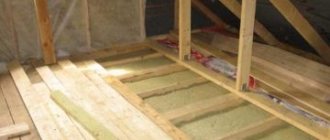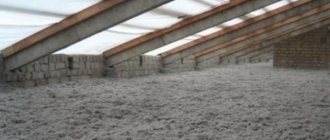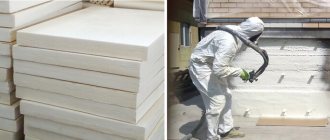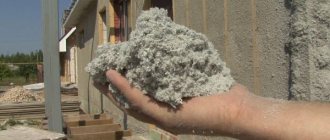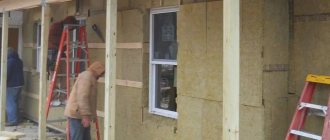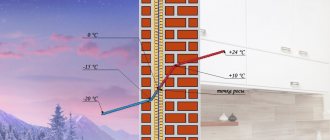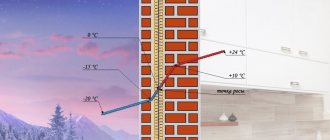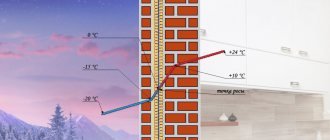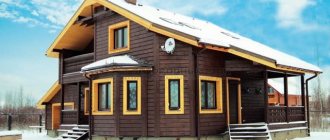One of the thermal insulation materials that is suitable for insulating a house yourself is ecowool. It is made on a cellulose basis, namely from wood fibers impregnated with brown and boric acid. Technological features of production make it possible to make the final insulation product wear-resistant, environmentally friendly, and energy efficient. When working, you can apply ecowool yourself. The structure of the substance ensures the necessary degree of filling the space of the treated surface. In view of these features, this type of thermal insulation should be considered in more detail.
Application methods
Cellulose wool has a loose composition. It contains grayish fibers. Cellulose insulation consists of 4/5 of used waste paper or newsprint and 1/5 of non-flammable substances that tend to reduce the likelihood of fire (usually borax and boric acid). The fibers are bonded together by lignin, which, when moistened, ensures reliable attachment of the composition to the surface being treated.
There are two methods by which ecowool is installed: wet and dry. They are used depending on the design features of the insulated surfaces. The dry method is different in that it does not require the use of a compressor.
The ability to evenly fill all the voids of frame buildings is an advantageous advantage of the dry technology of applying insulation, so during insulation work it is important to ensure the tightness and wind protection of the room. The insulation composition is supplied to the equipment hoses in a fluffy form. The process is not complicated, but requires compliance with a number of safety measures.
Cellulose insulation is suitable for insulating both internal and external walls, which makes this material universal.
There are two technological methods for installing thermal insulation:
- Blowing out. With this technique, the insulation composition is used to fill horizontal and inclined voids in frame walls. Thermal insulation is supplied through hoses through special holes in the wall. Ecowool fills the cavities inside, making insulation more effective.
- Open laying. A method that allows you to quickly fill open horizontal areas with insulation. Floor insulation with ecowool is often done using this method. The thermal insulation product is distributed evenly over the surface to be treated using a pump hose.
The wet method of applying ecowool is used when working on insulating external vertical sections and insulating interfloor ceilings. Roof insulation with ecowool can also be done using the wet application method. This technology differs from the dry method in the insulation composition. Dry raw materials are diluted with an adhesive or water base.
During installation, the need to carry out hydro- and vapor barrier measures in such places as:
- underground space;
- exterior walls;
- roof;
- ceilings between the attic and the lower floor.
Using special equipment for installation instead of manual installation will provide better thermal insulation, so hiring specialists to carry out the work will be the right decision. Organizations working in this area will provide prices for services that include both the cost of work and the cost of products. The consumption of ecowool can be assessed independently. It ranges from 40 to 65 kg per cubic meter depending on the surface. When applied horizontally, the consumption is minimal, when applied vertically – maximum.
Construction of houses
0 votes
+
Vote for!
—
Vote against!
Due to the inevitable deterioration of the environmental situation on the planet, both beginners and experienced craftsmen, when choosing thermal insulation materials, began to pay attention to products characterized not only by a high level of heat and sound insulation, as well as ease of installation, but also made from natural environmentally friendly materials. The possibility of self-installation is also valued by consumers, since in this case they get the opportunity to fully control each stage of applying the material, which will not only save money, but also, in case of any damage, fix it themselves. One of these materials is ecowool, which, despite the above characteristics, has not yet received due popularity, which leads to the fact that consumers often prefer foam plastic, already tested and tested by many builders, as well as mineral wool. We are confident that after reading this article, you will be convinced of the undeniable advantages of ecowool, as well as the simplicity of its application technique, which we will also talk about in this material.
Content
- Ecowool: structural composition and feasibility of use
- Main advantages of ecowool
- Disadvantages of ecowool: what did you not know about the material?
- Ecowool application methods: manual and automated
- Equipment for the automated method of applying ecowool
- How to insulate with ecowool: basic application methods
- Dry method of applying ecowool
- Wet installation method of ecowool
- Wet-adhesive method of applying ecowool
- Recommendations from experts on how to apply ecowool yourself
Ecowool: structural composition and feasibility of use
The lack of popularity of ecowool, associated with its recent appearance on the construction market, as well as the long absence of the necessary equipment for its application, is a completely fixable matter, since its undeniable advantages cannot go unnoticed. Thermal insulation material ecowool is characterized by a loose structure, 80% consisting of cellulose, which has the highest thermal insulation properties and excellent mechanical characteristics, due to which, after its application, a homogeneous layer is formed, devoid of seams and irregularities. But, despite its characteristics, cellulose is not used in construction work in its pure form, due to its high flammability. In the composition of ecowool, these properties of cellulose do not prevent its use, since in addition to cellulose, its structure includes a fire retardant, which is borax, and an antiseptic, boric acid. The use of these components in the structure of ecowool makes it absolutely fireproof and can be used for thermal insulation of boilers and chimneys. The use of boric acid helps prevent damage to the thermal insulation layer by rodents and insects, as well as the appearance of mold and mildew.
Important! Unlike ecowool, mineral wool does not contain boric acid, and therefore it is often damaged by rodents and insects.
Main advantages of ecowool
- Despite the fact that ecowool is practically unable to transmit wet steam and heat, it easily absorbs large amounts of moisture, and unlike mineral wool, this does not affect its thermal conductivity in any way. The thermal conductivity of the previous one, when the humidity level increases by at least 1%, increases accordingly by 8-9%. In this regard, you get the opportunity to use ecowool for insulation of wooden frame houses, where it will help maintain an optimal level of humidity;
- Due to the fact that ecowool is a homogeneous loose mass, if all the rules for its application are followed, a seamless layer with high thermal insulation characteristics is formed, while the formation of voids and cold bridges, which contribute to a decrease in thermal insulation characteristics, is completely eliminated;
- Ecowool, in comparison with mineral wool, has higher sound insulation characteristics and, unlike foam plastic, has higher elasticity, which also allows it to more effectively dampen any external sounds;
- Ecowool contains no substances harmful to human health. Absolutely safe lignin is used as an adhesive, while the antiseptic and fire retardant, which do not spray or evaporate, also do not pose any harm, which cannot be said about the commonly used polystyrene foam;
- Ecowool is a bulk material that, in the case of industrial installation, is pre-moistened. The material can be used without preliminary moistening; then ecowool is pumped into the frame using a compressor. Laying ecowool can also be done manually, which is the most labor-intensive and time-consuming method of application.
- Low chemical activity, due to which corrosion processes do not form at the points of contact between the heat-insulating coating and metal parts of fasteners or the building frame;
Important! Due to the random arrangement of cellulose fibers included in the ecowool structure, it eliminates shrinkage of the material in the case of vertical application. This contributes to the long-term preservation of the thermal insulation properties of the coating.
Disadvantages of ecowool: what did you not know about the material?
- Despite the fact that ecowool is an absolutely non-flammable material, it can smolder when exposed to high temperatures. In this regard, when insulating objects subject to heating, basalt or asbestos is additionally used;
- Application of ecowool is a process, the complexity of which depends on the method of its installation. To carry out installation activities correctly, sufficient experience and the use of specialized equipment will be required;
- During the process of insulation with ecowool, a large number of dust microparticles of cellulose and borax are formed;
- In the case of wet application of ecowool, subsequent installation activities can be carried out no earlier than a day later;
- And, perhaps, one of the most important disadvantages is the fairly high cost of ecowool insulation, which is several times higher than thermal insulation using traditional polystyrene foam and mineral wool.
Ecowool application methods: manual and automated
Installation of ecowool can be carried out in several ways, each of which is intended to achieve different purposes and is characterized by its own advantages and disadvantages. One of the simplest ways to insulate ceilings and floors is to manually apply ecowool. Despite the fact that this method is characterized by a number of advantages, there is a more modern - semi-automated method, which involves applying the material using a sprayer.
The manual method involves performing the work in stages, the first of which consists of pouring the required mass of insulation into a container of a certain volume. You can use bulk boxes or a bucket as this container. Taking into account the fact that ecowool is supplied to the retail network in compressed form, the next stage of work consists of “fluffing” the material. To do this, you will need a drill or a specialized attachment for mixing paints and varnishes. It must be remembered that after this activity is completed, the volume of material will increase at least three times. Having carried out the above steps, experts recommend proceeding with the direct installation of ecowool, which involves filling it into vertically oriented structures or floor coverings. In the process of manual laying, it is important to know the packing density of the material for each insulated element, which is, first of all, determined by the material consumption. So, for example, in the case of insulating floors, the optimal density of insulation is 35-50 kg per cubic meter. In the case of wall insulation, the required material consumption is 60 kg per cubic meter, and for roof insulation - 50 kg per cubic meter.
Important! If you need to insulate houses with a large area or cottages, the manual method of installing ecowool is unsuitable for this, since in this case you will have to resort to the use of specialized blowing equipment.
Equipment for the automated method of applying ecowool
To install ecowool using an automated method, you will need the following equipment for applying ecowool:
- An automatic blowing installation equipped with a specialized agitator, with the help of which you can produce a more uniform supply of heat-insulating material to the place of its direct installation;
- Corrugated hoses, which will be used to supply insulation to the work site;
- Water-adhesive installation of ecowool involves the use of a set of specialized foams;
- Wet spraying is carried out using an additional kit;
- A more modern version of specialized equipment involves additional equipment with blowing nozzles and electric trimming rollers, which will be required to remove excess material.
How to insulate with ecowool: basic application methods
Answering the question: “How to insulate using ecowool?”, we consider it necessary to consider all the main methods of insulation using this thermal insulation material. If we talk about applying ecowool using specialized equipment, it is necessary to consider three installation methods, such as dry, wet and wet-adhesive installation of ecowool, each of which will be discussed in detail below.
Dry method of applying ecowool
This method is especially relevant in the case of cellulose insulation of horizontal and inclined surfaces, as well as for carrying out installation activities in interfloor ceilings, and filling voids that represent closed spaces in the walls.
Installation of ecowool using the dry method looks like this:
The initial stage involves the organization of holes in confined spaces limited by membrane waterproofing, which will subsequently be filled with insulation. It is important to remember that the diameter of these holes must completely coincide with the diameter of the corrugated hose or spray nozzle, with the help of which the automated installation of the heat-insulating layer will be carried out. Subsequently, the newly installed hole is connected to a hose, which facilitates the flow of ecowool mixed with air to the place of its installation. The presence of air in the composition of the heat insulator contributes to its more efficient delivery to its destination, as well as to the maximum filling of the free space with ecowool particles with the subsequent formation of a durable cellulose plug. Free cavities are filled until they are filled with the required insulation density.
Applying insulation to surfaces located in a horizontal plane is done in a similar way, however, the only difference is that before applying ecowool there is no need to arrange preliminary insulation.
Wet installation method of ecowool
If you need to insulate vertical planes characterized by free access, wet application of ecowool will be the most optimal way to carry out thermal insulation measures. The fundamental difference of this method is that ecowool, pre-moistened with water, is applied to open surfaces that are freely accessible and limited by frame structures. Ecowool is moistened with the aim of maximizing the filling of the free space with insulation, which, due to the inclusion of lignin in the ecowool structure, which acquires stickiness upon contact with water, adheres tightly to the frame. If, after applying ecowool, you notice excess material clearly protruding above the frame, you need to resort to using an electric trimming roller, with which you can remove excess cellulose material.
Wet-adhesive method of applying ecowool
This method is in many ways similar to the previous one, but is characterized by one distinctive point, the essence of which is the addition of an adhesive substance to the structure of the heat-insulating mixture, which gives it a number of undeniable advantages. The most outstanding of them are the following advantages:
- Low probability of deformation of the cellulose material after it dries;
- Higher level of elasticity of the thermal insulation material;
- No harmful impurities in the material.
Applying ecowool using this method is most relevant in the case when it is necessary to insulate surfaces located in a horizontal plane and characterized by a lack of free access to their lower part. Typical examples of such structures are ceilings, structures located in a suspended position, as well as other thin-walled structures.
In the process of implementing thermal insulation by applying ecowool with your own hands, you can solve several installation and technological problems at once:
- Implementation of high-quality sound insulation;
- At the same time, you solve the problem of condensation in a room insulated with ecowool;
Recommendations from experts on how to apply ecowool yourself
- In order to correctly calculate the required number of ecowool packages, the weight of which is 15 kg, you can use online calculators on any construction site or make the necessary calculations yourself. To do this, it is necessary to multiply the area of the insulated surface by the technological consumption of material presented in our article;
- Experts recommend being guided by the following parameters. The recommended insulation thickness for the floor is 15-20 cm, for a pitched roof - 15-20 cm, for interfloor floors this parameter is 10-15 cm, for attic floors - 20-30 cm;
- When purchasing ecowool, do not forget that the consumption of thermal insulation material may exceed the calculated values by 10%, and therefore it is important to purchase material with a reserve;
- Initially, the characteristics of ecowool are such that it is intended for insulating wooden structures. In this case, it is applied directly to the surface, without the use of insulating materials. In the case of insulating surfaces made of metal, brick and concrete, before directly applying the insulation, it is necessary to “isolate” the ecowool from the surface being treated using an insulating material. This will prevent the formation of condensation in the room;
- During the installation of ecowool, it is important to take into account possible shrinkage of the material under the pressure of its own weight. This most often occurs in the case of insulation of high vertical cavities. To prevent this, horizontally oriented dividing partitions are installed in the insulated cavities during the installation of insulation, which help reduce the initial weight of the insulation;
- In case of roof insulation, it is also necessary to take measures to prevent the formation of sub-roof condensation.
Preparation for insulation using the blowing method
Insulation of walls and ceilings using the blow-in method begins with preparation for this process. If you plan to do the thermal insulation work yourself, then you need to purchase all the necessary equipment, calculate the material and prepare the working surface. Knowing the consumption of the substance per cubic meter and the thickness of the walls, you can determine what the consumption of ecowool is per 1 square meter. m.
Calculating the amount of cellulose wool required for insulation is an important procedure. Mistakes at this stage will lead to unnecessary costs for raw materials.
The consumption of ecowool per square meter of walls and ceilings varies, which must be taken into account when calculating the amount of ecowool required for work. Ecowool is transported in bags. One bag contains 0.14 cubic meters or, in terms of weight, 15 kg of thermal insulation composition. For a house with a base area of 60 m2, with an ecowool consumption of 50 kg per m2, you will need about a hundred of these bags. The amount of insulation depends on the thickness of the walls or floor slabs.
Areas of use of the material
Ecowool is a universal insulation material, which allows it to be used for insulating country houses, private houses, multi-storey residential and public buildings, industrial buildings, for arranging warehouses and retail outlets, as thermal insulation for saunas, baths and swimming pools. Due to its excellent soundproofing properties, this material is used in the arrangement of acoustic rooms and recording studios.
When insulating the walls of a house, dry and wet installation methods can be used. The attic, floors and roof are insulated using manual dry installation of insulation. To reduce heat loss in the attic, two methods of thermal insulation can be used: dry blowing of the walls with special equipment and manual laying of the material on the floor.
Dry plaster mixtures can be made on the basis of ecowool, which can be used to treat concrete, brick and gas silicate walls to improve their sound and heat insulation characteristics.
Wet method
Applying ecowool using a wet method is difficult to do with your own hands. Wet insulation is carried out only using expensive equipment. In a private home, the volumes are not so large that it would be economically profitable to carry out such work yourself.
The technology of laying ecowool using the wet method is applicable for thermal insulation work on the facade or under the roofing. On the facade, the technique is applicable only if finishing is possible. To supply wet adhesive-based composition, equipment with special nozzles is used to ensure uninterrupted supply of the composition under pressure. Drying time for insulation is 12 hours. Ecowool consumption when using the wet application method is 70-75 kg per square meter.
Due to its characteristics, ecowool eliminates the possibility of deformation of the thermal insulator during installation using the wet method. Condensation does not accumulate in the walls. Removal of excess material is done in a simple way - with a scraper and hands. After drying, the thermal insulation is hidden in the body of the wall with finishing materials.
Insulating the ceiling with ecowool using the wet application method will save time. Installation of insulation is carried out after installing a vapor barrier. Traditional methods of ceiling insulation are inferior to this method for several reasons. When insulating with ecowool, there are no microgaps between the main structures of the building and the insulation. In a wooden house, the wet application method can also be used to insulate the floor with ecowool.
Advantages and disadvantages of ecowool
In terms of thermal efficiency and vapor permeability, ecowool is on the same level as expanded polystyrene and mineral wool. The advantages of this insulation include the following:
- Ability to absorb moisture.
- Creation of a seamless thermal insulation coating.
- Excellent soundproofing characteristics.
- Environmental Safety.
The insulator perfectly absorbs moisture and subsequently quickly evaporates it. At the same time, there is no deterioration in the thermal conductivity of the material. Even with abundant saturation of the material with moisture, the insulation loses only 3% of its thermal insulation properties, which allows the insulator to be used in wooden houses as a natural, effective microclimate regulator, removing excess moisture from the air.
The ability to create a seamless thermal insulation coating eliminates the appearance of cold bridges and improves thermal efficiency. It is necessary to follow the installation technology and correctly calculate the amount of ecowool that will be required for thermal insulation of the walls of houses made of wood, brick, blocks and other materials.
An undoubted advantage is the complete environmental friendliness of the heat insulator. This insulation does not contain phenol or other components that may have a negative effect on human health. The boric acid and borax used are completely safe, they do not evaporate, so the material does not emit an unpleasant odor and is not dangerous to humans.
The disadvantages of this insulation include:
- If the technology for laying the insulator is not followed, its properties will significantly deteriorate.
- Low vapor permeability can impede air circulation in the room.
Dry method
The dry method is also applicable for insulating ecowool walls on the indoor and outdoor sides. As a rule, it is used when necessary to fill the voids in the walls of frame houses. Insulating the roof with ecowool using a dry method is also possible, but only if there is a frame to fill it with heat-insulating material. Ecowool consumption with this method is 10-15% more economical than when applying insulation using the wet method.
Before you start applying insulation, you need to prepare it. The raw materials arrive in pressed form, so it will be impossible to apply ecowool in a commercial form. Modern equipment has the function of fluffing raw materials with a built-in mixer, but if this is not available, then the composition will need to be fluffed manually. Subsequently, under the influence of high air pressure in the hose, the composition will reach the required state. The degree of “fluffiness” of the raw material affects the penetration of insulation into all corners of the cavity, providing maximum coverage.
Insulation of a block house (aerated concrete, gas silicate, foam concrete)
How to insulate aerated concrete or gas silicate houses with ecowool? Block houses are usually insulated from the outside. The sheathing is placed vertically in increments of 600-1000 mm and insulated using the wet-glue method. The concept of a breathable house also works in this case, and a vapor barrier film is usually not installed in them.
The main thing is that before insulating a block house, you need to calculate where the dew point will be in such a wall pie, since it may remain in the insulation. And although ecowool is okay with waterlogging, it is not endless.
Now let's talk about specific insulation units.
How to lay insulation manually
If you want to save on installation work to insulate your home, you can apply the insulation yourself. Do-it-yourself ecowool takes a lot of time to install. Blowing in the wall ensures greater density of insulation and filling of cavities with ecowool. When laying insulation manually, the consumption of ecowool is correspondingly reduced.
Before direct application, the insulation is laid out from the bags into a specially prepared trough, after which it is mixed with a mixer to give the material the required density and consistency. To do this, you will need to purchase a construction mixer or drill with a suitable attachment. Thermal insulation should be installed using personal protective equipment to protect the respiratory tract and mucous membranes of the eyes from dust.
How is insulation carried out?
This video talks in detail about wet and dry insulation. I think after watching you will have no questions left about how to insulate a house with ecowool. It is better to do it with the hands of masters. I initially wanted to insulate my house with ecowool with my own hands using a garden vacuum cleaner, but the deeper I delved into the topic, the more I realized that it’s not worth insulating the walls using the dry method - it will settle. But it’s impossible to do it with wet hands.
So at the same time I ordered ecowool from a specialist using both the dry and wet methods, why spend money on a vacuum cleaner that costs 5-10 thousand and waste months of time manually blowing it into the floor.
Installation equipment
If insulation is not done manually, then you should purchase the necessary equipment for installing ecowool. The installation for blowing ecowool is assembled on the basis of a vacuum cleaner. If necessary, you can assemble the entire blowing device for ecowool with your own hands. A detailed list of what equipment is needed for applying ecowool is given below:
- Vacuum cleaner Elitech BC 2000 power 2 kW/
- An electric drill or construction mixer with an attachment for mixing paint or dry mixtures.
- Container for mixing insulation raw materials 200 liters.
- Corrugated pipe for electrical cables with a diameter of 63 mm.
- Special electric roller scissors for trimming excess insulation
- Roll of tape.
Homemade equipment for blowing ecowool
Since professional equipment for working with ecowool costs a lot of money, craftsmen have come up with several substitutes. Here is a description of the most popular of these devices:
Things you need to stock up on in advance:
- In addition to ecowool, a mandatory component is a 2000-watt garden vacuum cleaner with the ability to regulate speed. Should provide air flow speed in the region of 170-250 km/h. You will have to spend around 3,000 rubles to purchase it;
- 7 m corrugated wires. It should have a diameter of 63 mm;
- Drill and mixing attachment for it;
- One part of the vacuum cleaner proboscis must be disconnected and the terminals must be moved to the main base. Due to this, the suction power will be increased.
- To prevent ecowool from clogging into the pipe that leads to the dust collector, it is necessary to remove the teeth that are located in this pipe. This is done with the help of wire cutters. Care must be taken, otherwise the plastic of the case may be damaged.
- After the teeth are removed, it is necessary to attach a corrugation with a diameter of 63 mm to the opening of the dust collector. Complete removal of the teeth ensures a smooth entry of the tube. You can secure it with tape.
- To prevent dust from flying to the sides during blowing, you can make an o-ring. The material for it can be cloth - we wrap it around the corrugation and press it against the wall while working.
- After completing all these steps, you will already have a device for ecowool. In order to start direct work, you need to find one assistant.
Ecowool: do-it-yourself insulation
When preparing to independently insulate a house with ecowool, you can use a kind of calculator to calculate the needs for cellulose wool, based on consumption data for each section of the building structure. The table below shows data on insulation consumption when insulating roofs, walls, and ceilings with ecowool. The table shows data on insulating structures of various thicknesses with insulation.
| Installation location Layer thickness | 50 mm | 75 mm | 100 mm | 150 mm |
| Horizontal designs | 2 kg | 3 kg | 4 kg | 6 kg |
| Vertical and inclined structures | — | 4.13 kg | 5.5 kg | 6 kg |
| Wet, wet-adhesive application | 3.5 kg | 5.35 kg | 7 kg | 10.5 kg |
The total volume of material is calculated by multiplying the surface quadrature by the consumption per 1 sq. m. It is important to take a reserve of 10% for unforeseen expenses. The area of the walls is calculated by multiplying the perimeter of the room by the height of the ceilings minus the area of window and door openings.
Description of insulation
Ecowool is a loose thermal insulation material that consists of 90% cellulose and includes various antiseptic components and fire retardants. Due to the mineral salt contained in ecowool, it has excellent antifungal and antiseptic properties. Good performance characteristics are largely ensured due to the presence of cellulose in the insulation, which is an environmentally friendly material that is resistant to moisture and fire.
Ecowool is produced using a special technology by processing waste paper with waste from the paper industry. The use of completely natural ingredients ensures that this material is completely environmentally friendly and completely safe for humans. Due to its porous, loose structure, the insulator provides excellent insulation of the house and is an excellent alternative to insulation materials such as polystyrene foam and mineral wool.
The excellent efficiency of this heat insulator and the versatility of its use make it possible to insulate houses with ecowool in private buildings built from wood, brick and foam blocks. Thanks to the affordable cost of ecowool and the ability to do all the work yourself, the homeowner’s home renovation costs are significantly reduced.
Ecowool or penoizol
Among insulation products there are several products that do not form seams during installation. Many people ask themselves what is better: ecowool or penoizol. Both substances have many advantages. However, it is worth noting that the first of them is a truly natural material made from wood. In addition, this insulation helps in the fight against rodents. Boric acid repels many pests, which is very important for residents of private homes. Penoizol has one drawback - when applied, it releases formaldehydes that are harmful to humans, which can also be released during a fire. But the right to choose still remains with the buyer.
What are the advantages of cellulose wool? Its components are low-toxic: antiseptic and antispirin are characterized by moderate harm to health. Eco-friendly cotton wool does not rot, does not burn in fire, and has high heat and sound insulation. It is capable of concentrating in the upper layers of the composition and retaining up to 20% moisture, which does not affect the consumer properties of the product. Without contacting substances on the surface, cellulose insulation does not corrode.
Ecowool insulation: material characteristics
Advantages of ecowool
The material is also called thermoflock and uniol. Cellulose in its composition occupies the predominant share - 81%. This material has excellent thermal insulation characteristics; its use allows you to create a seamless monolithic layer. But in its pure form it cannot be used in construction work, since it is very flammable, easily ignites, and is susceptible to the influence of various biological factors.
Adding useful fillers helps correct these characteristics. It is 7% borax and 12% boric acid. What do these components provide?
Borax is a reliable fire retardant, helping to reduce the flammability and fire hazard of the base material. Of course, to a certain extent. It is, of course, not recommended to insulate chimneys and heating boilers with such an insulator, but it is extremely good for interfloor coverings and walls.
How ecowool briquettes are packaged
Boric acid has a different function. It ensures that the material loses its attractiveness to various micro- and macroorganisms: rodents, fungi and mold. Its use guarantees ecowool protection from rodents better than that of mineral wool or polystyrene foam (it must be said that they even like the latter). The material also contains a certain amount of lignin, thanks to which the smallest particles of ecowool tightly bind to the surface of the insulated structure when moistened.
In what form is ecowool produced for insulation? This is a loose, unshaped mass consisting of cellulose fibers. It is compressed to a density of 110 kg/cubic meter. meter and briquetted, facilitating loading, transportation and storage. To be used, the material must be unpacked and fluffed to such an extent that its volume has approximately quadrupled.
Main performance characteristics:
- Flammability class - G2, moderate;
- Thermal conductivity coefficient – 0.037 – 0.042;
- Vapor permeability indicator – 0.3 mg/g;
- Mounting density – 26-95;
- Density – 40 g/meter cubed;
- Smoke generation – moderate D2;
- Flame spread over the surface – 0.
Main advantages
Like natural wood, the material allows you to breathe, and is also capable of absorbing up to 20% of moisture in the outer layer and then releasing it back. Unlike mineral wool, its properties are not lost, and in terms of thermal conductivity it is possible to obtain values comparable to foam insulation. There are three fundamentally different installation methods available. When applied to the surface, the insulation forms a seamless layer and is capable of filling the entire required volume. Ecowool is environmentally friendly and safe, as it does not contain evaporated substances, and additional impurities are present in small quantities.
This is interesting! Thermal insulation paint: types, composition and advantages of use
Review of the best ecowool manufacturers
An important criterion for choosing insulation is the manufacturer. The following brands have received positive user reviews:
- Isofloc. A German company with a worldwide reputation. Offers universal building materials that are suitable for insulating various objects.
- Termex. An experienced Finnish manufacturer that adheres to the canons of environmentally friendly products and innovative technologies. High quality ecowool is combined with a loyal pricing policy.
- Ecovilla. A company from Finland that has gained worldwide popularity due to the environmental friendliness and durability of its products.
- Ecowool Extra. The domestic manufacturer is the leader in the eco-insulation segment. Ecowool meets European quality standards, products are regularly tested and tested.
- Greenfiber. An American organization working on advanced technologies for processing raw materials.
- Equator". The products of the Russian brand are in demand by construction companies and private developers. The company's ecowool has high performance characteristics.
A little history about Ecowool
The properties of cellulose have been known for a long time
Research into the possibilities of paper material at the end of the 19th century interested manufacturers and led to the creation of ecowool production technology. At the beginning of the twentieth century - 1928, the first production facility producing cellulose insulation was opened. The championship belongs to Germany.
Since then, cellulose insulation has only victoriously gained popularity: in the USA, Canada, Europe, Japan and other eastern regions, it is recognized as the most environmentally friendly and inexpensive. In Russia, domestic cellulose thermal insulation material has appeared since 1993. The technology, equipment, and even the Russian name for this insulation came to us from Finland. In Finland, the share of ecowool (where it is called “Ecovilla”) among insulation materials for low-rise construction reaches 70%.
The production of ecowool and its use is only gaining momentum in the post-Soviet space: In Kazakhstan, the material has been produced since 1999, in Estonia - since 1990, in Lithuania - since 1994, and in Ukraine and Belarus - since 2007, and since 2012 production of “Ekovata-Nevskaya” was launched near St. Petersburg.
We assemble equipment for wet application of ecowool
This method ensures faster hardening of ecowool. It consists in the fact that in addition to the insulation itself, there is also a water jet or a mixture of water and glue.
You will need a pump and a flat spray nozzle. The end of the hose is fixed to the pipe through which the ecowool passes. In order for the outgoing jets to mix into a homogeneous mass, it is necessary to ensure equal pressure in both feeds by adjustment. If it is winter outside, the water needs to be heated. This way it won't freeze before the mixture is set. Make sure that the spray angle does not deviate from the 25° reading.
Check how the water saturates the solution. Try squeezing out the cellulose - only a few drops should come out. If there is more liquid, ecowool may fall off the surfaces. So adjust your equipment.
To add to water, choose thin and non-flammable glue.
So, a homemade ecowool installation will help you save money. But you can also rent such equipment in some large specialized stores.
Ecowool insulation has both supporters and ardent opponents. Many conjectures and myths circulated are the result of advertising by cellulose insulation manufacturers and their competitors. We will try to objectively evaluate the pros and cons of the material, based on its real properties, and also describe the most acceptable technologies for using ecowool.
Are there any disadvantages?
- In fact, the main disadvantage of ecowool is that additional equipment is required for its convenient installation. Moreover, it is required not only for the wet method of insulation, but will also be very useful for the dry method. Plus we need sufficiently qualified workers.
- In addition, the drying time for wet installation is 2-3 days. And, as you know, not everyone likes to wait.
Let's sum it up
The technical characteristics of ecowool described above show that it is no worse than any other materials for thermal insulation. In addition to this, it is undoubtedly environmentally friendly and durable. The use of technological equipment allows us to insulate a building or room of any size or shape in the shortest possible time.
What is the best way to apply ecowool?
Insulation can be used to fill niches in walls both outside and inside. This requires proper installation of a waterproofing layer that would protect the ecowool from excessive moisture absorption. In addition, the thickness of the walls must be compared with the calculated values of the insulation layer and determined whether it is enough for reliable thermal insulation or not.
Note!
Correctly applied ecowool has only positive reviews.
If the width of the niche is less than 7 cm, then you will not be able to insert a hose there and you will have to remove the trim. External or internal insulation is selected based on the location of the dew point inside the wall and to prevent the formation of condensation. If this is neglected, the walls will begin to become damp and collapse.
The photo shows the application of ecowool
Calculation of the amount of insulation and the density of its layer
When insulating the floor of interfloor ceilings, it is necessary to remember that the thickness of the layer of material should be 10-20 centimeters, and for the lower and upper floors - 20-30 centimeters. Density with manual open filling is 30-35 kg/m3, with mechanical blowing into a closed cavity - 40-45 kg/m3, and with mechanical open application the density is 35-40 kg/m3.
The mechanical method of blowing ecowool (between the joists) makes it possible to guarantee that the entire internal space of the floor is filled without leaving seams in it. This method allows you to achieve the optimal density of the ecowool layer and give it maximum thermal insulation characteristics.
